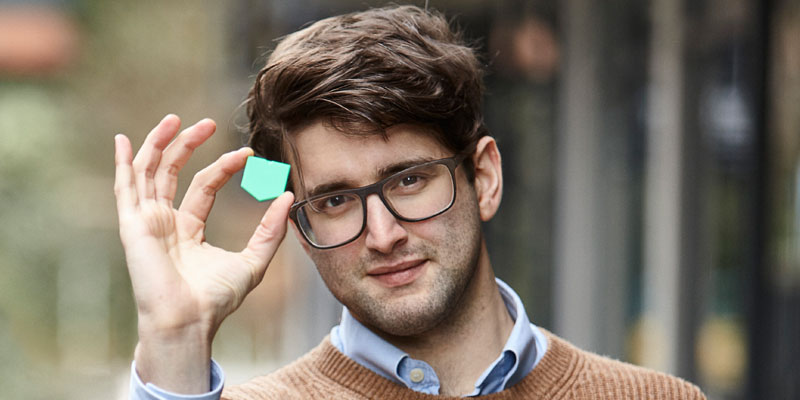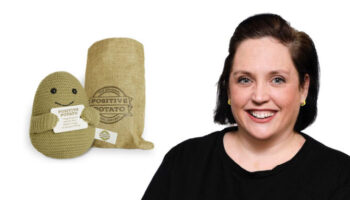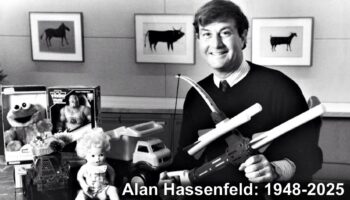FINH’s Filippo Yacob on harnessing creativity, making magic and teaching jellyfish to write poetry

Known to most as the co-founder of Primo Toys – the firm behind the popular coding robot Cubetto – this year has seen Filippo Yacob embark on a new venture in the form of FINH.
FINH is a kid-tech studio on a mission to make life a little more magical, and some of the projects it currently has on the go involve chairs that can think and learn, jelly fish that can write poetry and a real Pokedex for kids to discover nature through.
We caught up with Filippo to learn more about FINH, the challenges of the ed-tech space, and how he harnesses creativity.

Filippo – great to catch up. To kick us off, you’re incredibly passionate about innovation and play; when did your first develop an interest in these things?
It all started when I was eight. I wrote a letter to LEGO asking them for instruction booklets. I had a lot of LEGO – gifted, earned and inherited – but after I’d built the sets, I’d destroy them… And I never kept the manuals, which made the process of rebuilding quite frustrating!
My mum helped me write this letter and a few weeks later, I received a package from Billund, full of booklets, with a note inviting me to work there when I’d be old enough! My mind was blown. The abstract plaything that was LEGO suddenly became people I could write to, people that were making things, people with ideas and, I guess, people that I could be. That letter is the reason I became a kid-tech inventor, designer and entrepreneur almost 20 years later.
But my “adult” entry into the toy industry didn’t come through ‘toys’ at all. It came through ed-tech and a passion for creative technology and physical computing.
And that was with Primo Toys and Cubetto, the toy robot that teaches kids coding?
Yes, we started developing a little coding robot and a programming language that worked without a screen that didn’t exist. A lot of people know it as Cubetto, the smiling wooden robot, but the reason it resonated so loudly in the ed-tech and design community was because we effectively created a hands-on, block-based, procedural programming language that even a three-year-old can use.
The fact it was a toy was a by-product of us wanting to create a great learning tool, and there’s no better teacher than play – for anything. Cubetto has been all around the world, done record-breaking Kickstarter campaigns and taught 10 million kids how to code.
We also had some amazing people come through the company; Ben Callicott, who is now Product Director at Yoto… We gave Dimitri Hadjichristou his first job and he’s now a Digital Product Designer at GoHenry. My Co-Founder Matteo went to Google Creative Labs after this, and Cubetto is still the most impressive achievement in all our portfolios. It launched the careers of many of us.

Where did the seed of an idea for Cubetto come from?
Two things came about. In 2013, I learned that I was going to become a dad. My perspective on life and work completely changed, and I wanted to create something meaningful to me as a dad, so I started looking into educational toys. I came across the portfolio of Matteo Loglio – who became the co-founder of Primo. I grew up with Matteo in a small town called Bergamo – we skateboarded in the same square and got up to mischief. We’d lost touch though, but when I saw that he had created a concept that was the seed of Cubetto, as an evolution of Seymour Papert’s Logo turtles.
His Logo turtles are seen as the world’s first STEM educational robots, right?
Right. And when I saw what Matteo had come up with many years later, my jaw dropped. I told my wife “This is it!” I called Matteo and talked him into flying to London for a reunion. We met, talked and said, “let’s do it!” We had nothing to lose, we worked tirelessly over the summer of 2013, going back and forth from London and Turin.
Cubetto was just a box full of wires at that point, but we eventually worked up to launch our first Kickstarter campaign. Kickstarter was still a magical thing back then. We didn’t know what we were doing, but we made a video and the day we launched the Kickstarter, my wife went into labour. My son arrived, we launched the campaign and that’s how Cubetto started.
Great stuff – now, let’s dive into your new design studio; tell us about FINH, because the work you’re doing sounds fascinating.
I have jellyfish behind me that can write poetry with Machine Learning, I have a chair here that is intelligent enough to learn and think like you and I, we’re developing a space exploration program for kids, and we’re about to release a real-world Pokedex called ASH as our first product. It’s a madhouse!

It does sound very Willy Wonka.
Well, it is, but it’s real. We take technologies that seem obscure or buzzword-y and turn them into useful and entertaining everyday products. I read a quote the other day that said: ‘Any sufficiently advanced technology is indistinguishable from magic.’ That’s true and it’s what we do; we make magical things for learning and play.
Some of the things we design are whimsical, some are products that could live within a bigger portfolio at an established company, some are just end-to-end platforms that include multiple products and services. But all are delightful and magical.
Prior to launching FINH, I launched Pigzbe, a fin-tech platform for kids. It had its own cryptocurrency, it worked on the Stellar network and it had a hardware platform as well. It’s a great example of the scale of things we do here.
We have ideas in spades, but the focus is on learning and play. We also have a different model; I’m not really a gun for hire. We work on our own projects, we know what we want to build, and we invite anyone to come to the studio, check out our repertoire of magic tricks and tell us which one they want to collaborate with us on.
Do you think your creations appeal to mass market toy firms?
At the end of the day, technologies for kids are toys, they need that play element. We’ve built a real world Pokedex for kids aged six and up. It uses AI to help you discover nature. That might be perfect for National Geographic, for LEGO, for Spin Master… If any of them are interested in that sort of product, let’s talk.

Here’s another one… If you want to learn braille today and you’re a non-sighted child, you have to spend $1,000 for the cheapest digital alternative + lots of money on face-to-face tuition. We’ve created something that can retail at less than $100 and helps children learn the basics of braille independently. This is a niche example of what we’ve created, but It’s a learning technology that functions like a toy.
We make products and services that help as many people as possible. We focus on inventing and developing, and invite anyone to come and take our products over, manufacture them and distribute them.
Well, congrats again on the launch; it sounds exciting. I can’t move on without diving more into something you said earlier – you have jellyfish that can write poetry with machine learning! Talk me through that in a way I’ll hopefully grasp!
When I was at Primo, I got a chance to spend a lot of time understanding what it means to be a literate person in the 21 st Century. We came up with a thesis that there are four core literacies that should be learned as a child growing up today… The first one is computational thinking. The second is data gathering and analysis. The third one is machine learning and the fourth was infra-species communication.
At the time, people laughed at me when we’d talk about infra-species communication because it conjures images of talking dogs and cats! But all it meant to me was mastering communication between humans, machines, environments and animals – each has its own intelligence. Matteo wrote a beautiful book about this called Many Intelligences in fact.
What we’re trying to do with our three studio jellyfish, Moon, Moon and Moon – and it’s difficult because they don’t live very long – is understand the biological signals of the tank, their movement, and their feeding habits. We’re using machine learning to have them formulate readable, emotional pieces of poetry.
We want to see if we can find a better way for humans to understand the animal kingdom in way that’s not just numbers and graphs. Yes, they’re interesting, but reading something that humans can have an emotional response to, is going to make a different. That’s what the jellyfish project is all about.
Fascinating stuff! How do you fuel your creativity? What helps you wake up with ideas like the jellyfish project?
Well, there were points in the journey of Primo and Pigzbe where I’d forgotten how to think creatively, because I was solely focused on the survival of the business. But the problem is not being creative; the problem is having the discipline to turn that creativity into something viable. That’s something I’ve had to learn. If you don’t take the time to evaluate ideas, communicate them to those around you, and incubate them correctly, then a good idea can end up being worthless.
But essentially, ideas plus the skills to make them real enough is part of FINH’s DNA.
One more thing I’d love to pick your brain on. I looked back at some of the tech-infused toy firms that we’ve had speak at our events in the past few years, and I realised that many of them are no longer around. The brilliant Reach Robotics is no more, innovative companies like Sensible Object, LittleBits and Tech Will Save Us merged with other firms and your own Primo Toys is under new ownership. What is it that makes the ed-tech or tech-infused toy area such a tough space to enjoy longevity in?
It’s not a difficult question to answer, but there are several layers to it.
When Primo Toys was acquired by Moravia, a 20-year-old distribution company, I developed a wonderful relationship with the MD – Alois Hübl. Within a few weeks of taking over Cubetto, he had increased his margins by as much as 50% because of efficiencies, because he knew how to move boxes around the world efficiently, mostly because as a distributor, that was his only job.
We didn’t know any of that when we started, and I know the other companies you mentioned didn’t either. We knew how to make products! We tried to be a toy brand, a manufacturer, a distributor and we died. That’s what I see happening to every single one of us in this part of the industry, and it’s happening because we got the model wrong.
Personally, if I did Cubetto over again, we’d create the IP – the product – and then we’d go to a factory. They would make the product and we’d just connect them to distributors. If I’d gone down that route, we wouldn’t have had an overhead to manage supply chain and distribution, as well as inventory. We would have been paid for every unit sold via a license, from the factory to a distributor, and that would have been clean margin coming into the business.
Instead of hiring 20 people to manage logistics and operations, we could have had a team of five working on product, marketing and sales. That would’ve enabled us to move onto the next product faster. That is the mistake I made, and that I’m almost certain all of us in the space have made. So, one of the pieces of advice I give to ed-tech people doing hardware today, is don’t become a company that shifts boxes.
The other point is that towards the end of Cubetto and Pigzbe, my goal was to create the Mattel of the 21st Century – a big dream! My thesis was based around trying to acquire these ed-tech companies; the likes of Tech Will Save Us and Robo Wunderkind. I wanted to bring them all in, have one centralised supply chain and a distribution network for all of these wonderful brands.
It could’ve happened, but at the time, it was difficult to get everyone around the table because we all thought we were the next Apple. That would’ve saved all of us. We could have been a powerhouse – a real house of brands. The moment, however, is gone.
There is also something around expectations. Not every product is a business. It became a trend that we would all raise money at ridiculous SaaS like valuations, completely uncorrelated to our actual business, and when the penny dropped, we all found ourselves on our asses because the growth we all expected was not there, and the business model to reach such growth wasn’t there either. We were never going to hit that J Curve – the hockey stick doesn’t exist in our industry. From Kano to Little Bits to Primo, none of us have it, or have ever had it!
In the end, I wouldn’t really call ed-tech hardware a bubble, but there was definitely a trend; very few of us were realistic about what our businesses were capable of, and I’ll say it again. Not every product is a company.
Fascinating stuff, thanks for that Filippo. And that’s us out of time! A huge thanks again for taking time out for this, and all the best with FINH – it sounds magical. And folks can check out your latest project by clicking here.
—
To stay in the loop with the latest news, interviews and features from the world of toy and game design, sign up to our weekly newsletter here






















